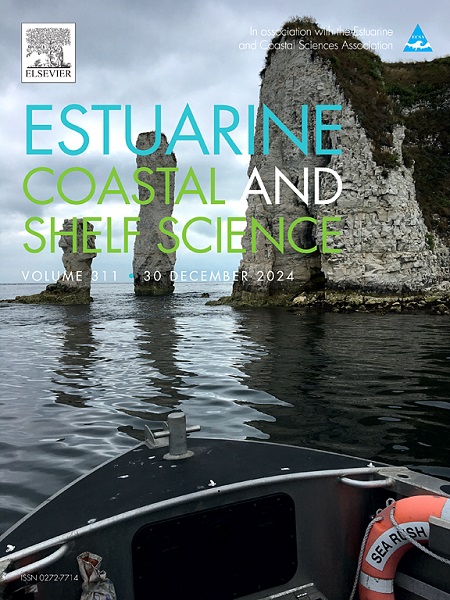海洋暴露的热带海滩中藻类漂移和形态动力学条件对鱼类群落和摄食行会的影响
IF 2.6
3区 地球科学
Q1 MARINE & FRESHWATER BIOLOGY
引用次数: 0
摘要
沙滩的冲浪带是形态动力学特征(例如,受潮汐影响的海滩与受波浪支配的海滩)影响鱼类分布的栖息地。此外,来自邻近海岸生态系统的藻类漂移(外来物质)是沙滩生境空间异质性的重要来源,为鱼类提供了避难所和食物资源。我们评估了海藻漂移对不同波浪条件下海滩上鱼类群落和食性行会(即浮游动物、鱼食动物、机会动物和底栖动物)的丰度、丰富度和生物量的影响。就整个鱼类区系而言,在不同的海滩上,鱼类的丰度和种类丰富度(而非生物量)存在差异。同样,在受潮汐影响的海滩和受波浪影响的海滩上,浮游动物食性鱼类的丰度和生物量(而不是丰富度)也存在差异。相反,在不同藻类体积类别中,腹食性鱼类的丰度存在差异,但丰度或生物量不存在差异,形态动力学特征不存在主要影响或交互作用。最后,形态动力学特征与不同种类藻类体积的差异相互作用,影响了机会主义者行会的物种丰富度,但不影响鱼的丰度或生物量。整个鱼类区系和机会动物区系的个体大小受海滩类型和藻类数量的影响,而浮游动物区系的个体大小仅受藻类数量的影响。在潮汐改造过的海滩中,栖食性鱼群的大小不受藻类体积的影响。鱼类对形态动力学条件和藻类漂移的反应具有行会特异性,这表明可能需要实施不同的策略来保护或管理这些营养群。本文章由计算机程序翻译,如有差异,请以英文原文为准。
Influence of algal drift and morphodynamic conditions on the fish assemblages and feeding guilds in ocean-exposed tropical beaches
The surf zones of sandy beaches are habitats in which morphodynamic characteristics (e.g., tide-modified versus wave-dominated beaches) influence the distribution of fish species. In addition, algal drift from adjacent coastal ecosystems (allochthonous material) is an important source of spatial heterogeneity within sandy beach habitats, providing refuge and food resources for fish species. We evaluated the influence of algal drift on the abundance, richness, and biomass of fish assemblages and feeding guilds (i.e. zooplanktivores, piscivores, opportunists and benthivores) on beaches with different exposures to wave conditions. For the entire fish fauna, abundance and species richness, but not biomass, differed between beach exposures. Similarly, abundance and biomass, but not richness of zooplanktivorous fish differed between tide-modified and wave-dominated beaches. In contrast, abundance, but not richness or biomass of benthivorous fish differed among categories of algal volume, while morphodynamic characteristics had no main or interactive effects. Finally, morphodynamic characteristics interacted with differences among categories of algal volume to affect species richness but not abundance or biomass of fish in the opportunist's guild. The size of individuals in the entire fish fauna and in the opportunists guild was affected by beach type and algae volume, whereas in the zooplanktivorous guild size was only affected by algal volume. The size of fish in the benthivorous guild was not affected by algal volume in tide-modified beaches. The responses of fish to morphodynamic conditions and algal drift were guild-specific, suggesting that different strategies may need to be implemented for the conservation or management of these trophic groups.
求助全文
通过发布文献求助,成功后即可免费获取论文全文。
去求助
来源期刊
CiteScore
5.60
自引率
7.10%
发文量
374
审稿时长
9 months
期刊介绍:
Estuarine, Coastal and Shelf Science is an international multidisciplinary journal devoted to the analysis of saline water phenomena ranging from the outer edge of the continental shelf to the upper limits of the tidal zone. The journal provides a unique forum, unifying the multidisciplinary approaches to the study of the oceanography of estuaries, coastal zones, and continental shelf seas. It features original research papers, review papers and short communications treating such disciplines as zoology, botany, geology, sedimentology, physical oceanography.

 求助内容:
求助内容: 应助结果提醒方式:
应助结果提醒方式:


